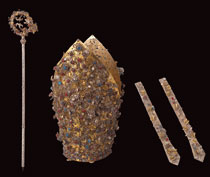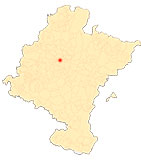Treasure of San Fermín
By Ignacio Miguéliz Valcarlos
Mitre and staff
Of special interest is the donation made to the Saint in 1766 by Don Felipe Iriarte, a native of Alcoz, Ulzama, who lived in Mexico, consisting of a "rich silver mitre gilded with its Pastoral Vaculum, adorned with exquisite filigree flowers and a variety of stones, butterfly tembleques and golden scorpions of rare beauty and pilgrim erudition". These pieces, although sent from Mexico, were carved in Cantonese workshops in China. The journey of these objects from their point of origin to their arrival in Pamplona is a long journey of great interest, not without its difficulties and adversities, Exempt .
Both the mitre and the crozier must have caused a sensation and astonishment in Pamplona, as the City Council of the city was extremely satisfied, sending Don Felipe, together with a letter of thanks, "twenty-four prints of the main plate of the said Glorious Saint, twelve of them on fine straw satin, and the other twelve on marbled paper, and a dozen booklets of his novena with their corduroy covers", prints which had been blessed by the Bishop of Pamplona, and the other twelve on marbled paper, and a dozen booklets of his novena with their corduroy covers", prints that had been blessed by the Bishop of Pamplona, at that time Don Gaspar de Miranda y Argaiz, who had granted forty days of indulgences for the aforementioned plates. Don Felipe de Iriarte replied to this letter in August of the same year, thanking the Regiment for its reply, as well as for sending the engravings and books, which, although they had not yet reached him, he said he was impatiently awaiting. The Town Council also thanked Doña María Fermina de Ciriza, who had received the objects and delivered them to the city, to whom four engravings of the Saint were given, two on satin straw and another two on paper, as well as two booklets of the novena. Likewise, a mass with a Te Deum was ordered to be held in the chapel of San Fermín in gratitude for the bequest received, accompanied by the cathedral orchestra. Before adding these works to the Saint's treasure, the Town Council commissioned the silversmith José de Jirau to recognise both pieces and weigh them, a task he carried out in the Town Hall.
San Fermín still wears these jewels on great solemnities. The mitre is made up of two sheets of gilded silver with ornamental incised and openwork flowers, on which is superimposed a rich and exuberant filigree decoration in silver in its colour and coloured glass, which is articulated around the plant and floral elements, which simulates a rosebush, on which different insects are arranged, such as butterflies and small scorpions, the latter gilded, all arranged in a variegated manner. agreement Several of these elements are attached to the mitre by means of threads and springs, in the form of tremblers or tembleques, as Felipe de Iriarte calls them in the documentation, which follow the fashion of women's jewellery of the time, in which pieces such as tremblers or airones were placed in women's hair or necklines, and with the movement of their wearers, these pieces sparkled, producing rich plays of light, very much in keeping with the taste for luxury and exuberance of the Baroque period. The mitre is accompanied by two infulas, strips made up of four plates joined together by means of a hinge, which are applied to the back to secure the mitre, and which have the same decoration of floral elements and insects in silver filigree as the mitre.
The crosier is composed of a cylindrical barrel decorated with incised vegetal and floral elements, with a silver filigree apple-shaped upper boss, divided into two symmetrical caps with openwork lobes or lobes decoration. The head or top, which forms a circle Closed, presents the same variegated decoration articulated by vegetal and floral elements in silver filigree, with superimposed insects, equal to those of the mitre, which extends towards the interior by means of three large filigree flowers.
-
ANDUEZA UNANUA, P., La arquitectura señorial de Pamplona en el siglo XVIII. Familia, urbanismo y ciudad, Pamplona, Government of Navarre, 2004.
-
ARBETETA MIRA, L., "Cadena y cruz pectoral del tesoro de San Fermín", in ARRAIZA FRAUCA, J., San Fermín patrono, Pamplona, Pamplona City Council, 1989.
-
ARRAIZA FRAUCA, J., San Fermín. El santo, la devoción, la fiesta, Pamplona, Pamplona City Council, 2002.
-
GARCÍA GAINZA, M. C., and others, Catalog Monumental de Navarra. V***. Merindad de Pamplona, Pamplona, Government of Navarre-Archbishopric of Pamplona-University of Navarre, 1997.
-
HEREDIA MORENO, M.C., "Ejemplos de mecenazgo indiano en la capilla de San Fermín de Pamplona", in yearbook de programs of study Americanos, Tomo XLVI, 1989.
-
HEREDIA MORENO, M.C., "Bandejas y jarras del tesoro de San Fermín", in GARCÍA GAINZA, M.C., and FERNÁNDEZ GRACIA, R., (coords.), Juan de Goyeneche y el triunfo de los navarros en la monarquía hispánica del siglo XVIII, Pamplona, Fundación Caja Navarra, 2005.
-
HEREDIA MORENO, M. C., ORBE SIVATTE, M., and ORBE SIVATTE, A., Arte hispanoamericano en Navarra. Plata, pintura y escultura, Pamplona, Government of Navarre, 1992.
-
MIGUÉLIZ VALCARLOS, I., "El tesoro de San Fermín: Donación de alhajas al Santo a lo largo del siglo XVIII", in Promoción y Mecenazgo del Arte en Navarra. Cuadernos de la Chair de Patrimonio y Arte Navarro, nº 2, Pamplona, Chair de Patrimonio y Arte Navarro, 2007.
-
MIGUÉLIZ VALCARLOS, I., "Sacras con los patronos de Navarra y Pamplona", in FERNÁNDEZ GRACIA, R. (coord.), Pamplona y San Cernín 1611-2011. IV Centenary of the city's vow, Pamplona, 2011.
-
MOLINS MUGUETA, J.L., Capilla de San Fermín en la iglesia de San Lorenzo de Pamplona, Pamplona, Diputación Foral de Navarra, 1974.
-
MOLINS MUGUETA, J.L., "La mitra y báculo dieciochescos de San Fermín", in Diario de Navarra. Extraordinary of San Fermín, Pamplona, 1984.
-
MOLINS MUGUETA, J.L., "Mitra y báculo de San Fermín", in MORALES, A. J., Filipinas, puerta de Oriente: de Legazpi a Malaspina, Barcelona, SEACEX, 2003.
-
MOLINS MUGUETA, J.L., "Mitra y báculo del tesoro de San Fermín", in GARCÍA GAINZA, M. C., and FERNÁNDEZ GRACIA, R., (coords.), Juan de Goyeneche y el triunfo de los navarros en la monarquía hispánica del siglo XVIII, Pamplona, Fundación Caja Navarra, 2005.
-
ORBE SIVATTE, A., Platería del reino de Navarra en el siglo del Renacimiento, Pamplona, Government of Navarre, 2000.
-
ORBE SIVATTE, M., Platería en el taller de Pamplona en los siglos del barroco, Pamplona, Government of Navarre, 2008.












